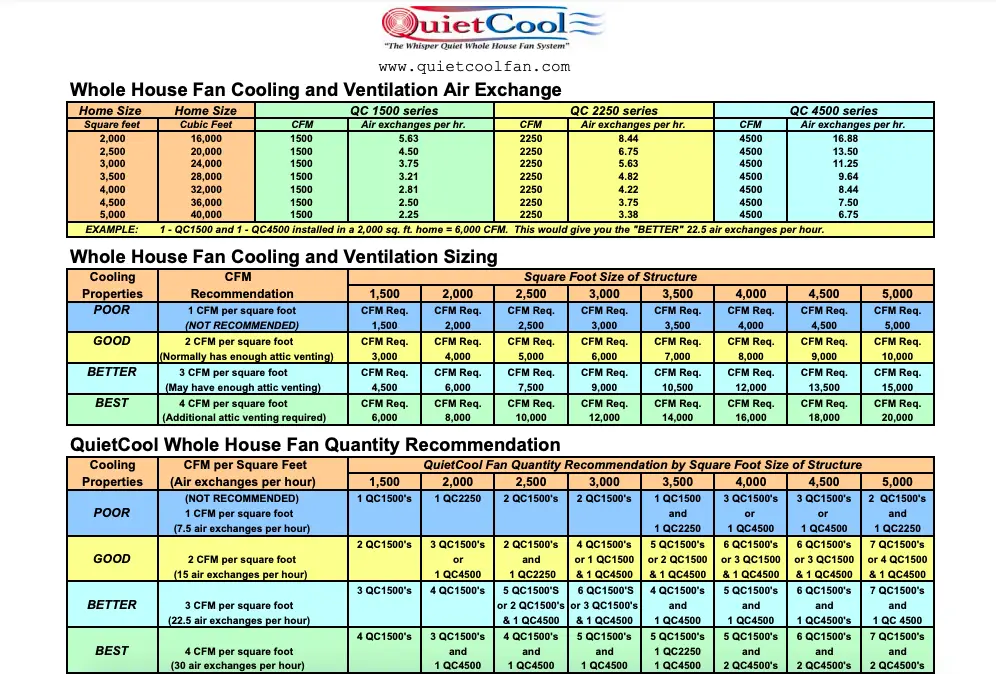Whole house fans are the next best thing after canned tuna. They come in difference sizes and power ratings. But how do you decide which one of them is the right choice for your home?
Here is a detailed guide;
What size whole house fan do I need?
What size whole house fan do you need? According to experts, you will need a whole house fan that has a CFM rating of 2 to 3 times the square foot area of your home. For example, if you live in a 2000 sq.ft house you will need a whole house fan with ratings between 4000 to 6000 CFM.
CFM needed = Area of the house x 3 (Formula 1)
Let’s see in detail how we reached this size calculation. For that, here are some formulas to keep in mind;
The volume of air in a house (Cu.ft) = Sq.ft area of the house x average height of the ceiling (form 2)
The volume of air needed to move in an hour = number of air changes needed x Volume of air in the house (form 3)
CFM required for the whole house fan = Volume of air movement in an hour/60 (form 4)
The basis of whole house fan size calculation is the number of air changes required in a house. According to the experts at Energy.gov, an official wing of US Department of Energy, a whole house fan need to make 3 to 6 air changes per hour.
One air change means replacing the whole air inside the house with new air. So that is basically the volume of the living areas of the house. So if you have a 2000 sq.ft house with an average height of 8 ft then the total volume of air that needs changing is 16000 cubit ft.
For the above example, in order to make 3 air changes, the whole house fan will need to remove 3 times 16000 Cubic ft of air.
So, total air that need moving in an hour = 3 x 16000 = 48000 cu.ft
CFM means cubic feet per minute. So to calculate the CFM for a fan to remove 48000 cubic feet of air an hour we need to divide this value by the number of minutes in an hour.
Therefore, fan CFM = 48000/60 = 800.
According to Energy.gov, the maximum number of air changes needed is 6. So if we do the math based on that, then the CFM required, in this case, would be 1600.
But those CFM values are nowhere near the one we get if we used Formula 1 which is given at the very beginning of this article. If we calculate the CFM using that formula its value will be 2000 x 3 = 6000 CFM. The difference here is huge, isn’t it?
This is because in practice there will be many obstructions due to the layout of the house and so to draw air properly you will need a more powerful fan. That is why HVAC technicians recommend whole house fan CFM ratings to be 2 to 3 times the square feet area it needs to cool.
QuietCool, a very popular brand in this industry, recommends 15 to 22 air exchanges for effective cooling. Here is a size guide recommended for Quietcool whole house fans;

What is the importance of geographical location when deciding the CFM rating for a whole house fan?
Whole house fans cool the house by drawing cool air from the outside. In cool climates, the inside temperature can be lowered by a few air exchanges whereas if your home is in a hot climate area the number of air changes needs to be more. So having a larger fan in hot climate areas make sense.
Central vs Zoned systems
In a central system there will be only one whole house fan usually fitted on the ceiling of the hall way. But you can use more than one whole house fan for a more effective cooling (How to use a whole house fan). This system is called a zoned system.
In a zoned system the CFM rating is calculated based on the total of the CFM rating of individual fans. So if the CFM rating needed as per calculaton is 6000 CFM you can use two 3000 CFM fans instead of a single, large fan.
What is the fan size for a two story home?
The whole house fan size for a two-story home is the same as that of a one-story home. But in this case, implementing a zoned system is better. You can use one fan for each level. This also provides better control of the ventilation process.
Problems with buying fans of the wrong size
As mentioned before the recommended CFM size of a whole house fan is 2 to 3 times the area it need to cool. A smaller fan will take longer times to complete air changes which means more time to cool the house. This will also add more load on the fan’s motor reducing its life.
It is ok to use an over-powered fan. But in this case make sure that the attic ventilation is good. Over-powered fans will drive a lot of air into the attic, and if the attic is not properly ventilated the fan will build a positive pressure inside it. The recommended attic ventilation is 1 sq.ft per 750 sq.ft of attic space. But of you are using a large fan, multiply that value by two.
Recommended whole house fans and their sizes
| Area (Sq.ft) | Recommended CFM | Recommended models |
|---|---|---|
| 1000 | 2000 – 3000 | |
| 1500 | 3000 – 4500 | Cool Attic fan |
| 2000 | 4000 – 6000 | QuietCool CL-6000 |
| 2500 | 5000 – 7500 | Cool Attic CX302DDWT |
Related Posts:
- Ducted Whole House Fan Reviews: 4 Best Picks
- 3 Best 30 inch Whole House Fans for Cooling Large Spaces
- How To Make A Whole House Fan Quieter: 5 DIY Tips
- 4 Quiet whole house fans with whisper-quiet operation
- Roof Mount Whole House Fans For Flat Roofs Without Attic
- How to winterize a whole house fan? Are covers effective?
- Whole House Fan Installation Questions & Answers
- How to Use A Whole House Fan – 8 Steps
- How Much Energy Does A Whole House Fan Use?
- Is A Whole House Fan Compatible With A Ridge Vent?
- Are Whole House Fans Worth It? Good Or Bad Analysis
- Whole house fan sizing guide – Finding the right CFM
- Whole House Fans vs Attic Fans: 8 Interesting Differences
- What is a whole house fan and how does it work?
- 5 Best Whole House Fans to Buy

